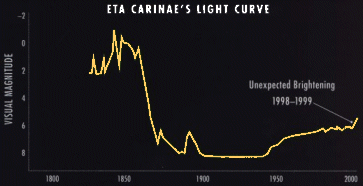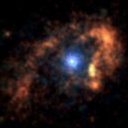Sovereign of the South
 |
| NASA/HST image of Eta Carinae and its pair of billowing gas and dust clouds. |
Majestic, legendary, extreme, powerful, rare, enigmatic, gigantic... adjectives that describe Eta Carinae, the massive supergiant star that, surrounded by a beautiful and distinct nebulae, illuminates the southern Milky Way sky. This extraordinary star is among the most luminous and most massive stars known to exist at about 4 million times the brightness and 120 times the mass of our sun, it is dangerously close to the theoretical limit for a star. Eta Carinae belongs to a rare class of stars called Luminous Blue Variables, or LBVs. Roberta Humphreys from the University of Minnesota explains, "Most stars above 40 to 50 solar masses will eventually go through an LBV instability phase". As the star sheds its mass it slowly evolves from a blue supergiant to a Wolf-Rayet star, thought to be one of the later stages of stellar evolution, and then the next and final act, astronomers believe, is to explode as a supernova.
Before Eta Carinae terminates itself in a supernova explosion, however, it continues to mystify astronomers! The largest puzzle to understanding this star is that scientists do not know what caused Eta Carinae's Great Eruption of the 1840s.
The Great Eruption
 |
Sir John Herschel (1792-1871) English Astronomer. Ilustration after the portrait by H.W. Pickersgill. |
In the early 19th century, Eta Carinae was considered an unusual but undistinguished variable star, sometimes glowing at 4th magnitude, sometimes at 2nd. Then in the 1830s, Sir John Herschel (son of the famous English amateur observer William Herschel) noticed that the star's light had risen steeply and, by December 1837, had reached 1st magnitude. Upon further research, Herschel discovered that the star had brightened to 1st magnitude twice before, once in 1827 and again in 1832. After fading in 1838, the star soared in 1843 to a fiery magnitude of -1, thus becoming for a brief period, the second brightest star in the sky, outshone only by Sirius.
For the next twenty years, Eta Carinae sparkled brilliantly as one of the brightest stars in the galaxy. Accompanying this colossal eruption and visual brightening was an expulsion of about two to three suns' worth of material from the star's polar regions. This material spewed from the star at speeds close to 700 kilometers per second forming the two distinctively large, grayish, bipoloar lobes seen in the Hubble view of Eta Carinae. Each lobe currently expands at a rate of 1.5 million miles per hour and spans about four trillion miles. The glow from these lobes comes mainly from starlight radiated by Eta Carinae that reflects off the ubiquitous dust contained inside the lobes. Although they provide a spectacular visual show, the clouds that surround Eta Carinae obscure the star from direct visual observation, which creates some uncertainty in the accuracy of the light curve.
 |
| Reproduced by permission. Copyright, 2000, ASTRONOMY magazine. |
A Mysterious Puzzle
What caused the Great Eruption of 1843? It is a mystery that has not yet been solved, although many astronomers believe that the key components in the expulsion of several solar masses of material are the extremely large mass and high temperature of Eta Carinae. LBV objects like Eta Carinae must periodically shed additional large amounts of mass to remain stable. The most popular hypothesis proposes that the star's luminosity (radiation pressure) becomes so great that it overpowers the effects of gravity that hold the star together. The star becomes unstable; its outer layers pulse in and out struggling to establish the most stable position. Eventually an eruption occurs and the outer layers are blasted off into space. It is not clear whether this war between gravity and radiation pressure is the sole cause for the eruptions. Other scientists believe that turbulence and convection on the star's surface either contributes to or causes the outbursts. And still more scientists are convinced that no current theory can be correct because none seems to explain sufficiently what instigates the eruptions as well as what makes them stop. |
| A NASA/Hubble view of the Homunculus Nebula reveals material thrown off in the 1843 Great Eruption. |
Is Eta Carinae a binary or single star? This is another mystery not yet solved, however most astronomers support the binary hypothesis. Augusto Damineli of the University of Sao Paulo in Brazil discovered, upon analysis of the star's spectrum, that every 5.5 years Eta's ultraviolet and x-ray output undergoes a short-term change. In the x-rays the flux increases steadily, then plunges, followed by a slow recovery. In the ultraviolet, several dark emission lines on the star's spectrum disappear. Damineli has been able to trace this cycle back through the last 50 years. He successfully predicted a recent event in December 1997, where the x-ray output plummeted and the UV emission faded, according to his predictions. Based on this cycle, astronomers propose a binary star theory that would explain previous eruptions as a result of the orbital interactions of two stars. Although not all scientists agree on this theory, most agree that the star's powerful x-ray emission is propelled by the collision of two dense stellar winds, emanating either from the two stars of a close interacting binary system or from the fast and slow stellar winds of a single star. In general, astronomers remain skeptical of all theories because no hypothesis yet explains the observed phenomena.
Why is Eta Carinae brightening across all wavelengths? Jon Morse of the University of Colorado notes, "Without question, the central star has brightened since 1997 by roughly a factor of two." Morse continues to explain that if the brightening trend continues, in two years Hubble will be unable to image Eta without saturating because the star will be too bright. No one anticipated that this star would climb to bright magnitudes so soon. And what is stranger is that no one can explain why it is happening across all wavelengths. If the star was only brightening in the visual wavelengths, it might be explained that Eta is shedding an outer layer in response to radiation pressure whereby the star's outer layers cool and its output shifts from ultraviolet to visual wavelengths, however, this is not what is observed. Brightening is occurring across the entire electromagnetic spectrum, implying an intrinsic brightening of Eta Carinae. "And Eta Carinae can't brighten very much," notes Humphreys, "or else it will go boom."
All Eyes On Eta
The recent brightening of Eta Carinae reinforces the importance of observing and studying this star in many different wavelengths. A plethora of astrophysical topics can be researched by observing Eta. Some of these include: stellar physics (interiors, atmospheres, winds, instabilities, rotation, and evolution), gas dynamics, atomic physics (peculiar excitation processes), non-routine radiative transfer, abnormal dust formation, and other subjects.
 |
 |
 |
| Left: Radio image of Eta Carinae at 5 GHz (ACTA, S. White et al) http://www.astro.umd.edu/~white/index Middle: At 18 microns, Eta Carinae is the brightest extra-solar object in the mid-infrared. Image by E. Polomski, UF mid-IR detector, OSCIR at CTIO 1998. Right: Chandra X-ray image shows region around Eta Carinae. The outer horseshoe ring is 3 million degrees Kelvin and the innermost white region is hottest and contains Eta. | ||
At radio wavelengths Eta Carinae produces the brightest known stellar wind. A recent increase in radio emission has occurred because cool gas close to the star has been excited by a blast of radiation.
At infrared wavelengths, Eta and its nebula are the brightest objects in the sky beyond our solar system. The mid-infrared emission of Eta Carinae originates in dust ejected by the star during giant mass-loss events within the past several hundred years.
Eta is a unique source of x-rays. The outer horseshoe shaped ring has a temperature of about 3 million degrees Kelvin. It is about two light years in diameter and was probably caused by an outburst that occurred more than a thousand years ago. The blue core area is hotter than the ring, and the inner white region is hottest and contains the variable star Eta.
When you observe Eta Carinae you are looking down the length of our Galaxy's Carina-Sagittarius spiral arm, home of many massive and beautiful nebulae. To observe Eta, first you must be located south of the equator because this superstar, at a declination of -60 degrees, will not rise for northern latitude observers. March and April are excellent times to find Eta because it is highest in the sky from late evening to midnight. First locate the bright Eta Carinae emission nebulae (NGC 3372), the brightest area in the Milky Way. Eta sits within this nebulosity just north of the dark shaped V that cuts through the nebulae's center. Then submit your observations to the AAVSO to be included in the AAVSO International Database and help record a very important brightening of this star.
The beautiful nebulosity surrounding Eta provides a spectacular visual showing. Another spectacular show will be the gigantic explosion when Eta Carina goes supernova! At about 7, 500 light years from Earth, there should not be any threat to life here so we can watch the show and seize an exceptional opportunity to learn more about stellar evolution.
For More Information
- Davidson, Kris. "Crisis at Eta Carinae?", Sky and Telescope, January, 1998, 37-40.
- Malin, David. "The Splendor of Eta Carinae", Sky and Telescope, January, 1987, 14-18.
- Morse, Jon A., Humphreys, R., Damineli, A. Eta Carinae at the Millenium, A.S.P. Conf. Ser., Vol. 179, 1999.
- Zimmerman, Robert. "Scoping Out the Monster Star", Astronomy , February, 2000, 38-43.
This month's Variable Star of the Month was prepared by Kate Davis, AAVSO Technical Assistant, Web.

